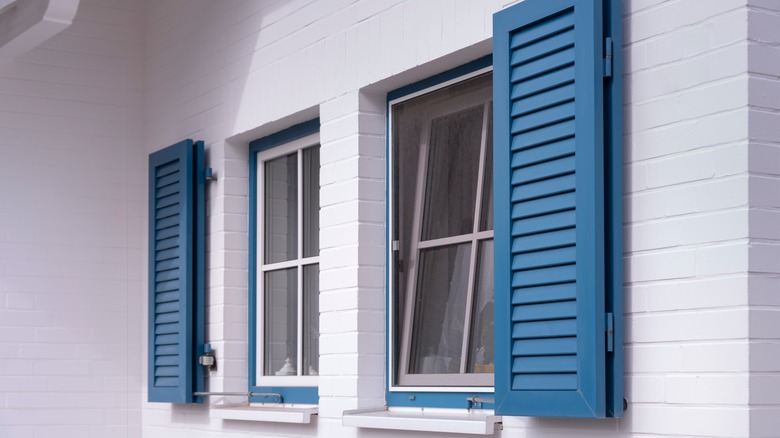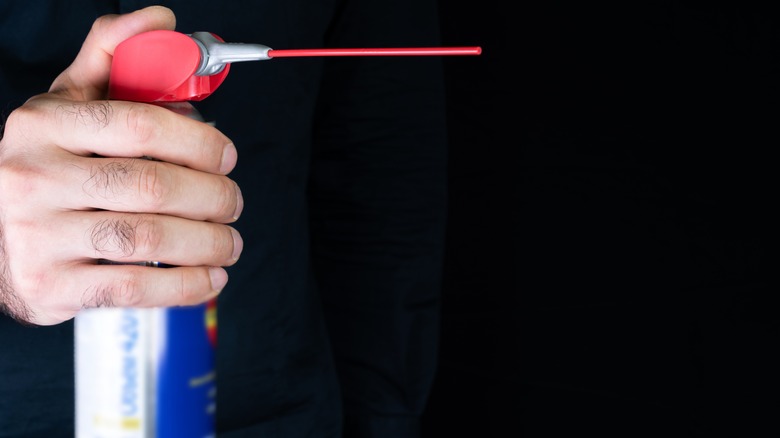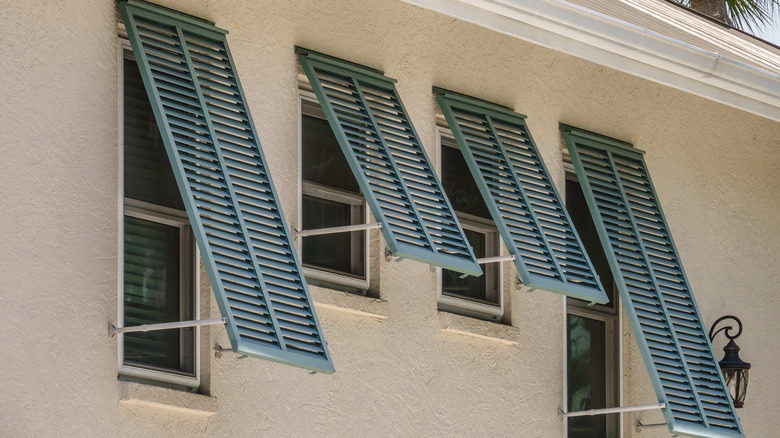The Type Of Shutters You Should Never Use WD-40 On
WD-40 can be used in a lot of different capacities, from rust prevention to stain removal. Yes, WD-40 is well-known for its usefulness in fixing squeaky hinges, but it's this ability that also makes it handy in so many other areas. The "WD" of its name stands for "water displacement," meaning it keeps water away, accounting for all the ways it prevents build-up and grime from sticking to metal. However, there's one way you should never use WD-40 at home, and that's lubricating hurricane shutters.
Hurricane shutters are meant to protect your home from heavy winds and storm damage. There are many different variations of these protective shutters, from ones that roll down to storm panels made from aluminum or polycarbonate. In the event of a hurricane or other impending catastrophic weather event, deploying your shutters could mean the difference between major property damage and coming out unscathed. It's therefore imperative that your hurricane shutters are well-maintained and in good working order. This absolutely includes keeping the hinges and tracks of your shutters well-lubricated, but WD-40 is not good for this purpose.
Why WD-40 is bad for hurricane shutters
While WD-40 is a water displacement product, it is also water soluble, meaning it can be dissolved in water and leaves mineral oil behind. So, while WD-40 is excellent at preventing, for example, small amounts of water from causing rust on tools, it is not a match for the deluge of water that accompanies the storms hurricane shutters are designed to protect against. Such an onslaught would dissolve the WD-40, rendering it useless in preventing corrosive damage to your shutters or in keeping them moving freely.
Moreover, the lubricating effects of WD-40 are not meant for use on the machinery and gears that make up the inner workings of your hurricane shutters. WD-40 is great for a simple hinge on a door, leaving a thin coating of oils that reduces the friction coefficient between the two interlocking metal surfaces, allowing them to move smoothly against each other. However, those oils can paradoxically collect dirt and other particles over time. In the case of the complex gear systems on hurricane shutters, the introduction of these particles can gum up the machinery at best, or cause irreparable and costly damage at worst.
Use silicone lubricants to maintain your hurricane shutters
Hurricane shutters are, by definition, exposed to the elements in their harshest forms. In order to work right, their gears need to be properly lubricated and insulated against damage from the weather. Dry silicone lubricant sprays, available at home improvement stores, are not made of water or oils. In fact, they repel water, as well as dirt, and are particularly good to use in destructive weather conditions because they aren't susceptible to extreme temperature changes.
To maintain proper lubrication on your hurricane shutters, first close them over your windows and thoroughly spray them off with your garden hose or power washer, ridding them of any dirt and grime that's accumulated. Then open them up and, wearing protective eye gear, spray your silicone lubricant along the wheels of the tracks. With accordion shutters, there's only the top track, whereas rolling shutters have them on both the left and right side. Test the opening and closing of the shutters to ensure the track runs smoothly, then close the shutters entirely and spray lubricant along the folds. Finally, don't overlook the shutter locks, spraying liberally all around and inside the mechanisms to ensure they don't stick. Perform this maintenance twice a year and your shutters will always be ready when you need them.


